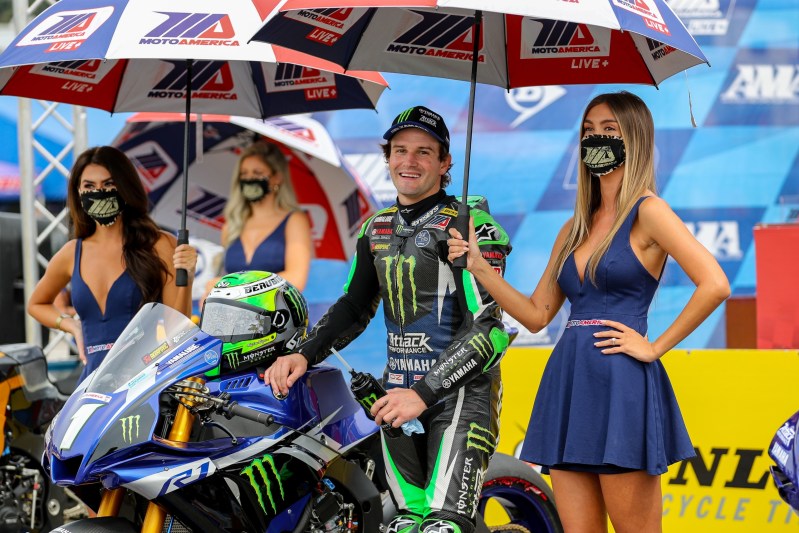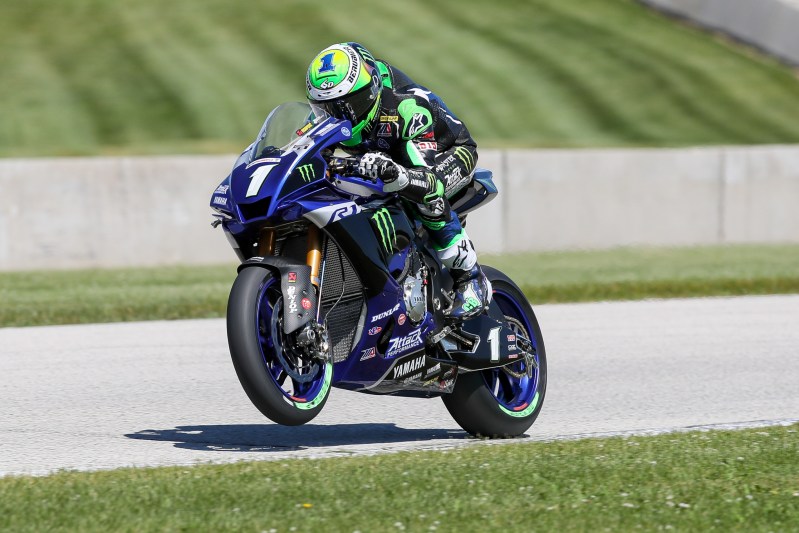You can trace so-called Superbike racing on motorcycles and courses comparable to those seen in MotoAmerica races today back to the early 1970s. Thus this decidedly high-speed sport is nearly two decades older than the man who is arguably its top competitor, Cameron Beaubier.

While still in his mid teens, Beaubier went over to Europe where he would race for several years. He participated in the Red Bull Rookies Cup, and soon in a World Cup competition. Back in America, Beaubier “struggled through a couple privateer years” (“privateer” referring to racing without major sponsorship) before achieving results in several races that were “enough to get Yamaha’s attention.”
He has since earned the attention of racing fans, fellow competitors, and sponsors far and wide.
With nearly 50 wins and counting, Beaubier has come to dominate the fastest motorcycle racing sport in America. Racers ride bikes capable of hitting speeds over 190 miles per hour, and these are no straight shot drag race style competitions: The average Superbike race course twists and turns like a coiled snake, and the courses, which blend road and dirt, will indeed bite anyone not ready for the challenge.
It has been on a Yamaha bike that this young rider has enjoyed his successes “ever since signing up with them for the 2011-2012 season.” So how does someone become a top-tier MotoAmerica racer? For Cameron Beaubier there was really no other logical course for his life to follow.
When did you first get into riding bikes?
Cameron Beaubier: I grew up in Northern California in a family of motorcycle enthusiasts. My dad raced growing up, doing motocross mostly, same with my uncles, they all raced a lot on dirt, so I grew up seeing that and doing that. I got my first bike when I was four. It was a little Yamaha PW50. That was just what I knew. I grew up playing soccer also, but going to the track, that’s what I did for fun. I didn’t really take it that seriously, but when I started switching from motocross on the dirt to SuperMoto, which is a hybrid, like 70% on pavement, 30% dirt and you ride on street tires, I just really took a liking to the pavement.
I started getting some success there at SuperMoto racing, started getting some pretty good results at a pretty young age. I started thinking I might be able to do something with this more than just ride for fun. It’s a pretty crazy feeling: We’re on 400-pound motorcycles with 220 horsepower, which kind of puts it in perspective.
There are 3,ooo pound cars with much less power, then?
CB: Oh yeah, the power-to-weight ratio is amazing. So when you’re just sitting there on the line, it’s an amazing feeling. For me, I’m not like a pump-up guy, I just want to get ready to do it, to get up to the line and go in calm. Once the race starts it’s all focus and adrenaline, but before, you feel the bike rumbling, you hear the 20 other motorcycles nearby rattling around. It’s intense.
What is an actual Superbike race like?
CB: It’s a lot of things. I mean you have to be fit, to be ready, but what’s cool about road racing is that it’s a little bit of everything. You’re on slick road tires, but there’s also some dirt. You have to be ready for risk, we’re going at speeds right up to 200 miles per hour. But once that red light goes, you don’t really think about that, you’re in your flow. In the back of your head you obviously know you could get hurt, you could slide out or tangle up with someone, there’s definitely a lot that goes into it.
The average MotoAmerica race is between 50 and 55 miles, which is about 40 laps in total, and they last about 30 minutes each, nonstop. (Thus the focus on rider fitness and training — the average person off the street would be beyond exhausted after just a few minutes under such conditions.) Thus it’s little surprise Beaubier describes the primary feeling at the end of each race as “relief.”
I mean of course if I win, there’s a lot of excitement. [Racers] see how much work goes into this, all the behind the scenes stuff, and when I win, it means the team won. There’s just no better feeling than knowing all the hard work all the guys put in paid off. It feels so good to get that done for them and for yourself. But really it’s relief. I’ve worn a heart rate monitor a few times, and I average 180 beats [per minute], and it’s 30 minutes, so it’s just exhausting.

Is the sport as dangerous as many people construe, or is that a misconception?
CB: I mean for sure you can get hurt, it is dangerous, but in this day and age, the helmets are so good, the leather suits so tough, the bikes even have things like traction control that keep you safer. We even have things now like air bag technology introduced by my leather suit company Alpinestars and it detects G-forces and can blast out airbags around your head and neck if it detects a crash or fall. So yeah, things can happen, you can get hurt, but in reality it’s not as bad or dangerous as it looks.
What gives you the edge that has led to so many podium appearances?
CB: I think a lot of it goes back to my time in Europe when I was young. They have a slightly different style of riding there. They carry a lot of corner speed and a lot of lean angle, and I learned that at such a young age. It definitely helped me because I use more roll speed than the other guys here. But everyone has their own style of riding. Yeah we’re all on the same track on similar bikes, but we all ride our own way. Some guys shoot it out on the straightaway, some people use a lot of brake force. I think I just keep carrying speed whenever I can and that really helps.
(So far, said carried speed has led to more than 45 total wins and four championship victories. The winningest racer to date, Aussie Mat Mladin, has seven championships. But Mladin retired in 2009 before age 38. Beaubier is only 27.)



